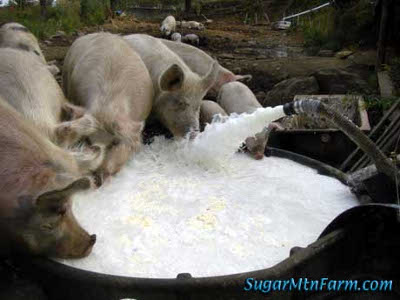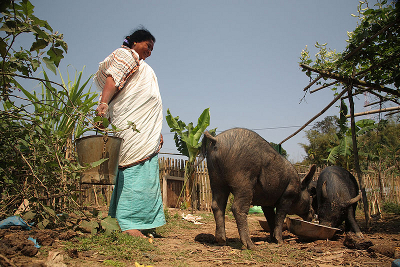
Feeding pigs
 Now for the thorny part of
pig-raising --- feeding. As with most other livestock, the modern
method is to pour grains (and soybeans) down their throats to produce
fast growth. At the other extreme, diversified farmers like
Walter Jeffries raise their pigs with absolutely no purchased grain,
counting on fruit-tree-filled pastures, crops planted during fallow
periods then grazed rotationally, and byproducts such as whey and
brewer's barley to fulfill their hogs' nutritional needs. Going
back in time yet further, a hog was a bit of a farm garbage disposal
unit --- you'd keep just one or two pigs and they'd subsist on all of
the food waste that came out of a homestead kitchen, plus mast from the
forest.
Now for the thorny part of
pig-raising --- feeding. As with most other livestock, the modern
method is to pour grains (and soybeans) down their throats to produce
fast growth. At the other extreme, diversified farmers like
Walter Jeffries raise their pigs with absolutely no purchased grain,
counting on fruit-tree-filled pastures, crops planted during fallow
periods then grazed rotationally, and byproducts such as whey and
brewer's barley to fulfill their hogs' nutritional needs. Going
back in time yet further, a hog was a bit of a farm garbage disposal
unit --- you'd keep just one or two pigs and they'd subsist on all of
the food waste that came out of a homestead kitchen, plus mast from the
forest.
 While I'd love to mimic Jeffries' method
in the long run, we're in the reclamation stage of our homestead, so I
suspect we'll be taking a hybrid approach our first year. Klober
notes that a quarter of an acre of good legume pasture will provide 25%
of the nutrition for 10 growing hogs, so I'm hoping a similar amount of
poor forest pasture will provide at least a bit of nutrition for
2. But we'll also supplement with storebought feed (and with our
food scraps, which will be much more copious in late summer).
Klober says we should expect to feed each hog 650 to 750 pounds of
storebought feed over its short lifetime, and I'll definitely be
keeping track to see how much we knock off that estimated total.
While I'd love to mimic Jeffries' method
in the long run, we're in the reclamation stage of our homestead, so I
suspect we'll be taking a hybrid approach our first year. Klober
notes that a quarter of an acre of good legume pasture will provide 25%
of the nutrition for 10 growing hogs, so I'm hoping a similar amount of
poor forest pasture will provide at least a bit of nutrition for
2. But we'll also supplement with storebought feed (and with our
food scraps, which will be much more copious in late summer).
Klober says we should expect to feed each hog 650 to 750 pounds of
storebought feed over its short lifetime, and I'll definitely be
keeping track to see how much we knock off that estimated total.
Finally, there are two
schools of thoughts on how much food to offer growing
hogs. Some farmers provide unlimited feed, which does make pigs
grow their fastest. On the other hand, if you limit feed to 90%
of their appetite, you end up with a leaner
carcass (although you don't lower your food bill any since the hogs
grow more slowly). Most modern farmers aim for leaner meat, but
as Simon
Fairlie wrote,
farmers used to consider lard one of the most important byproducts of
hog production, so the choice is up to you.
| This post is part of our Storey's Guide to Raising Pigs lunchtime
series.
Read all of the entries: |
Want more in-depth information? Browse through our books.
Or explore more posts by date or by subject.
About us: Anna Hess and Mark Hamilton spent over a decade living self-sufficiently in the mountains of Virginia before moving north to start over from scratch in the foothills of Ohio. They've experimented with permaculture, no-till gardening, trailersteading, home-based microbusinesses and much more, writing about their adventures in both blogs and books.
Want to be notified when new comments are posted on this page? Click on the RSS button after you add a comment to subscribe to the comment feed, or simply check the box beside "email replies to me" while writing your comment.

The lard is an important component of the homestead. Fat is one of the most overlooked foods that is often taken for granted, and lard and butter are the easiest to produce on the small homestead.
With the current rage either low-fat, or buy exotic Irish butter and coconut oil, homegrown lard is often overlooked.
How come cattle panels instead of hog panels? I have a love/hate relationship with both, you can't live with them or without them.
We go full-feed with our pigs with added homestead scraps and milk. They graze and do what they do despite having feed 24-7. Our big thing here is that we need them to be gone before the rains set in or they ruin the wet ground too much. So we could grow them slower, but it ends up making a mess and isn't worth it for a little more feed, IMO, in our location/climate.
Nita --- We chose cattle panels in part because I'm very new to fencing and don't really know what I'm doing. But my theory is that I want to be able to use them as permanent fencing and keep other types of animals in those paddocks in the future, so I wanted a bit more height than hog panels afford. Unfortunately, when the panels showed up, they weren't quite what the feed store lady said they would be on the phone, so the holes at the bottom aren't small enough to keep in much --- we may have to add something there after all. I'd be very curious to hear your take on the utility of the various types of livestock panels. (And I agree with you on the importance of fat front.)
But my theory is that I want to be able to use them as permanent fencing and keep other types of animals in those paddocks in the future, so I wanted a bit more height than hog panels afford. Unfortunately, when the panels showed up, they weren't quite what the feed store lady said they would be on the phone, so the holes at the bottom aren't small enough to keep in much --- we may have to add something there after all. I'd be very curious to hear your take on the utility of the various types of livestock panels. (And I agree with you on the importance of fat front.)
Mitsy --- I know what you mean. I'm very curious to see how your and our hybrid feeding approaches stack up. Now I understand why you wanted to be sure to get your pigs early, too if you want them to have such a long grow-out period.
We actually don't use them much for animals, more for garden trellis etc., so the cattle panels are unwieldy and heck if you move them a lot. But a semi-permanent fence like your building the cattle panel probably makes more sense.
We have used the hog panels for a moveable type pen for two pigs - 4 hog panels fastened in the corners with quick links and we could move the pen along, once they reached about 100 pound though, all bets were off unless we made the pen very secure, which then defeated the purpose.
You can put a low hot wire around the inside perimeter to help keep the hogs away from the panels, but you will still have to check it, because they will root dirt on the wire and short it out when you have the least amount of time to be chasing pigs!